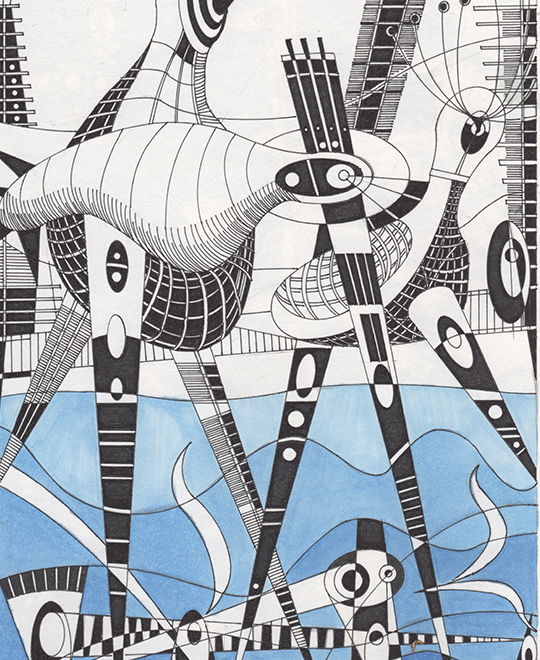Studio 05
HOPE IN PETURBANISM_ Great Ocean [Road?]
Justyna Karakiewicz

This studio is available to students enrolled in ABPL90142 Studio C, ABPL90143 Studio D, and ABPL90115 Studio E.
Studio Description
The name Great Ocean Road, itself reflects a culture in which human activity dominates. As the coast is threatened by erosion and rising sea levels, the role of a road demands reconsideration with a reassessment of our value systems and cultural priorities. This thread of asphalt is symptomatic of a crisis, not only for its purpose of connection but also for its priorities. The road is a representation of our conundrums.
Extensive evidence calls increasingly for a recognition that urban and natural ecosystems should be considered as continuities, not disjunctures. From the CAS perspective, urban form can be considered as part of the natural system to contribute to a better quality of life for all species, that is, turning our focus from ‘people-centric’ to ‘life-centric’ development for all.
If you want to work hard, to experiment, to be brave, to abandon a lot of theories that you previously learnt, and do something different and exciting, to learn, then this studio is definitely the one for you.
Studio Outcomes
We will be designing something that will allow something else to happen; this may be something that we cannot predict but that it might improve the environment in which we live. And in order to do this, we will need to abandon our preconception that humans are constantly under threat from nature, and we need to fight it back with design (Colombina & Wigley, 2019). We are not the only species worth preserving.
We will have to forget most of urban theories in which deterministic progressions are privileged. In place of these, we will adopt Complex Adaptive System (CAS) theory that postulates that any healthy system requires periodic perturbation (disturbance).
Studio Leaders
Professor Justyna KARAKIEWICZ, BArch(Hon) AA Dip PhD MSAI RIBA FRSA, trained as an architect at the Architectural Association. She taught at the Architectural Association, Bartlett School of Architecture, University College, London and spent 14 years as Associate Professor at The University of Hong Kong. Currently Professor at The University of Melbourne. She has exhibited work in Royal Academy (London), Venice Biennale (three times), New York, Kyoto, Barcelona, Hong Kong, Beijing, Sydney and some twenty other venues. Her numerous successes in international competitions include First Prizes in: Gateway to Mecca (1979); Crystal Palace Solar Housing Competition (1981; built); Dunkerque Waterfront (1992; partially built); Swansea Working Men’s Club (1995; built); awarded Prize at Royal Academy Summer Exhibition for the best drawing (2005); Honorable Mention and prize in Asia Front Village 39th Central Glass International Architectural Design Competition sponsored by Shinkenchikusha Co., Ltd., Prize (2004); Honorable Mention in Modern Saudi House Design Competition (2004); Honorable Mention in eVolo Annual Skyscraper Architectural Competition (2006); First prize for Spinney Garden project completed 20 years ago, Housing Design Awards 2008 Historic Awards (2008); Second Prize in the Austral Bricks Design Ideas Competition (2010). Justyna has published over 60 papers, 12 book chapters and three books: The Making of Hong Kong and Promoting Sustainable Living: Sustainability as an Object of Desire and Urban Galapagos published in December 2019.
Readings & References
- Colomina, B. and Wigley, M. (2018) Are We Human?
- Rossi, A. (1982) The Architecture of the City,
- Guallart, V. (2010) Self Sufficient Cities,
- Latour, Bruno. “Down to Earth: Politics in the New Climatic Regime”.
- Richard J. Weller, “Précis” in Richard J. Weller, Claire Hoch, and Chieh Huang, Atlas for the End of the World (2017)
- Whiston Spirn, A. Ecological Urbanism: Framework for Design of Resilient Cities,
- Ricci, D. Designing at the Present Tense
- Monteiro, Mike. (2019) Ruin by Design
- Sanford Kwinter and Cynthia Davidson, Far from Equilibrium: Essays on
- Technology and Design Culture,
- Michael Batty, Lu.s MA Bettencourt and Michael Kirley. ‘Understanding CoupledUrban-Natural Dynamics as the Key to Sustainability’
- Crawford Stanley Holling and Lance H Gunderson (eds), Panarchy: UnderstandingTransformations in Human and Natural Systems,
- Brendan Kempf, ‘Urban disturbances’
- Steward T.A. Picketta , Brian McGrathb , M.L. Cadenassoc & Alexander J. Felsond, (2013) Ecological Resilience and resilient Cities
Schedule Wednesdays 09:00-15:00